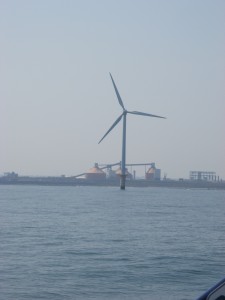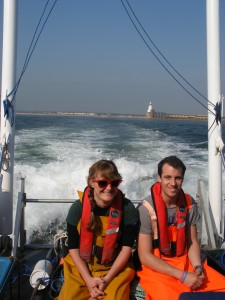It is with great pleasure I get to place the first blog to the new site. It is even more exciting that I can do this on behalf our International Marine and Environmental Consultancy (IMEC) MSc students, who as I write this, are making me insanely jealous doing boat work in the fine weather while I’m tied to the office today.
Yes, it is MSc project time and this year we have six students from among the IMEC programme undertaking the ambitious task of conducting an Environmental Impact Assessment of the National Renewable Energy Centre marine wind farm development planned (conveniently for us) just off our local coast.
Based aboard Newcastle University’s brand new catamaran research vessel “The Princess Royal”, the students have 15 sea days to collect the data ultimately required to deliver their project, an EIA work package. This is career relevant skill development in the fast lane. By the end they will have led their own work package and supported sampling with a wide range of techniques (trammel netting, sediment grabs, drop camera, swathe bathymetry, visual and acoustic mammal survey). Their final reports will be presented to a client panel including members of two different environmental consultancies, a regulator and the developer.
But I get ahead of myself. Eight days in and with the sun shining and almost perfect sea conditions I joined those on the boat for a day of trammel netting (a curtain like net set on the seabed) and sediment grabs. I took with me Abi (a former IMEC student herself) and Richard from RSS Marine, a consultancy near Filey in Yorkshire who came to grab a few quality control and training samples. What better way to meet potential employers than to work alongside them.
Meeting at 8:00 to kit up we headed out at around 8:30am and spent the first hour of two steaming a circuit dropping trample nets on pre-identified points out to about 3nm. This was followed by about 3 hours of sediment grabs (replicated drops a 4 sites) which were sieved onboard and then a repeat of the circuit picking up the nets after a 4 hour soak. It looked bad when the first haul went for a duck. Catches picked up however, with the biggest catch of the sampling programme to date obtained that day.
A particular favourite of the day was a catch of hagfish, a scavenging/carrion species of primitive jawless fish that play an important role in recycling nutrients. They are also one of my favourite fish despite (or perhaps because of) being totally disgusting. They are eel like, capable of secreting a huge volume of slimy mucus for defence and have the rather pleasant habit of eating a fish from inside out leaving only a bag of skin containing bones. They were hitting our catch of the day hard and are a major pain to local fisheries. Still with fair weather we finished an hour or so early. After an early start, sun, sea and as good meal I was out for the count. It was a fantastic day.



